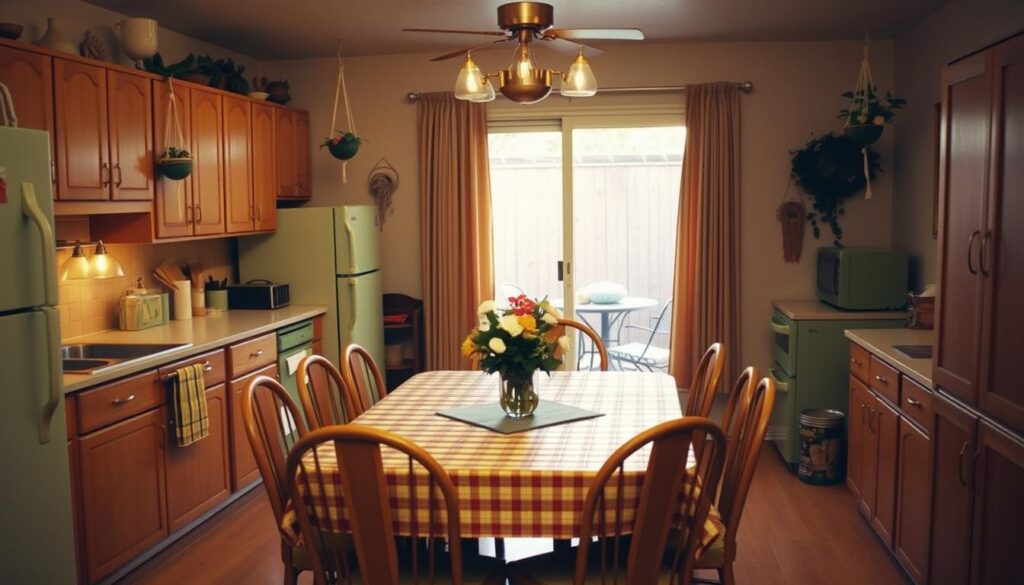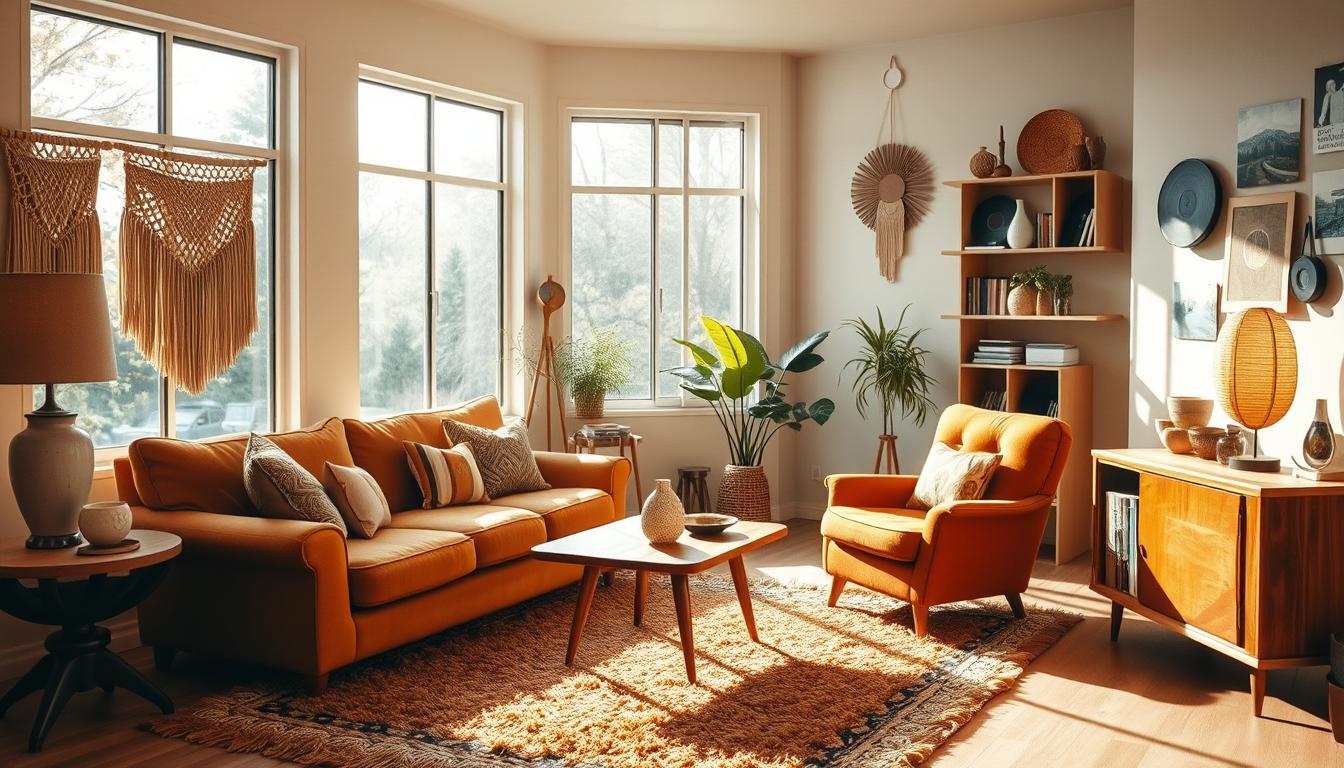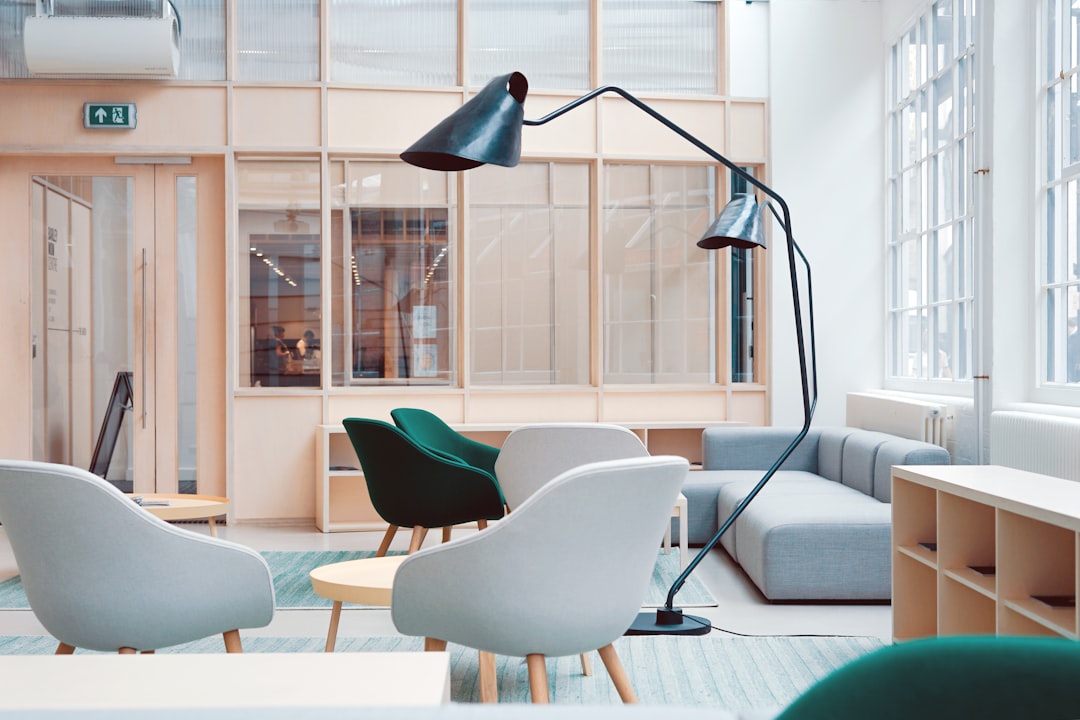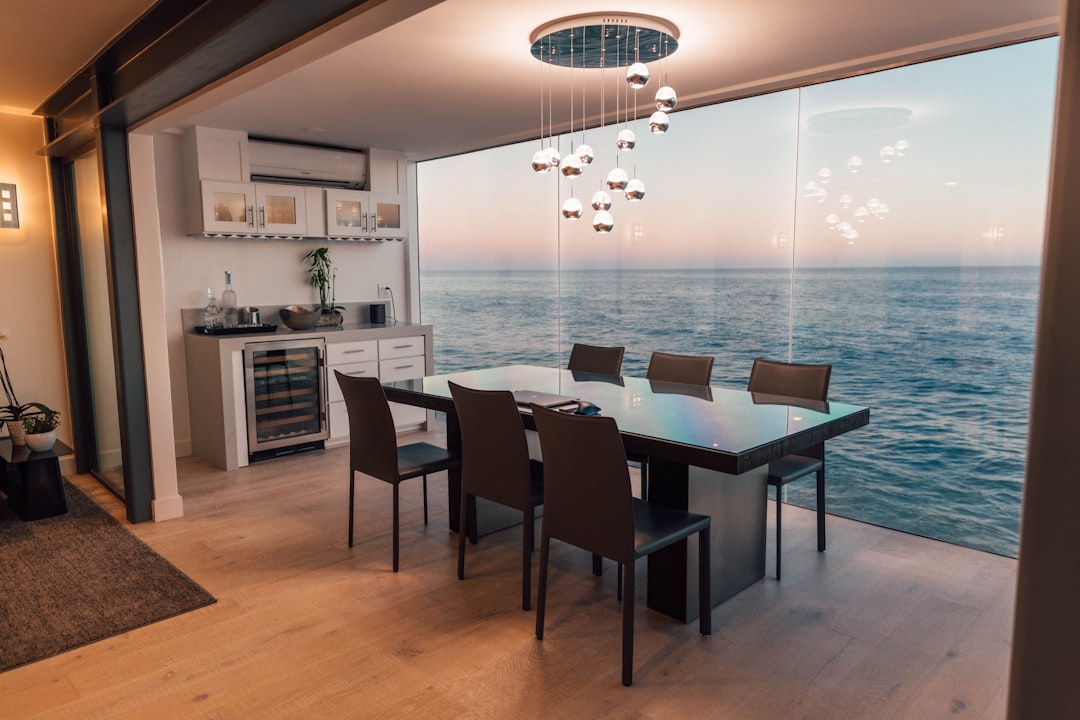The 1970s was a decade of bold expression. Its retro decor still influences vintage home styling today. This era is known for vibrant colors, eclectic patterns, and a mix of textures. It’s all about embracing individuality and self-expression.
To bring this iconic style into your home, we’ll look at key elements. We’ll cover statement furniture and bold color schemes. By adding these retro touches to your space, you can create a unique and groovy vibe. This vibe honors the era’s cultural and social changes.
Key Takeaways
- Understand the core characteristics of 1970s retro decor
- Learn how to incorporate vintage elements into modern homes
- Discover the importance of bold colors and eclectic patterns in 1970s interior design
- Explore statement furniture pieces that define the era’s style
- Create a groovy atmosphere by mixing textures and patterns
Understanding the Characteristics of 1970s Interior Design
The 1970s interior design was unique, showing the cultural and social changes of the time. This decade saw many design trends, from funky and vibrant to sleek and modern.
Key Elements of the Era
The 1970s design was shaped by mid-century modern style. It featured clean lines, organic shapes, and simplicity. The era also loved bold patterns, bright colors, and statement pieces.
- Emphasis on functionality and simplicity
- Incorporation of natural materials and textures
- Use of bold colors and patterns
Color Palettes and Patterns
The 1970s were known for their vibrant colors and patterns. Earthy tones like avocado green and harvest gold were popular. Bold jewel colors like emerald green and sapphire blue were also favored.
Paisley, florals, and geometric prints were popular patterns. They added visual interest and personality to rooms.
Popular Materials Used
The 1970s introduced new materials like vinyl, chrome, and glass. These materials gave spaces a sleek and modern look. Natural materials like wood and wicker added warmth and texture.
In the disco era design, materials that shone and sparkled were key. Metallic finishes and glittering fabrics reflected the era’s glamour and nightlife.
Iconic Furniture Styles from the 1970s
The 1970s were all about bold furniture statements. This era celebrated creativity in interior design. Iconic pieces defined the era’s style.
Statement Sofas and Chairs
Statement sofas and chairs were key in 1970s interiors. They featured bold colors and funky patterns. These pieces became the room’s focal point.
Oversized, plush furniture became popular. It encouraged relaxation and conversation. Rounded shapes and curved lines added elegance to rooms.
The Rise of Modular Furniture
Modular furniture became popular in the 1970s. It allowed homeowners to customize their spaces. Modular sofas and shelving units were favorites for their flexibility.
This trend showed how lifestyles were changing. People wanted furniture that could adapt to their needs.
Coffee Tables and Side Tables
Coffee and side tables in the 1970s were made from glass, wood, and chrome. They were both functional and decorative. Unique shapes and designs added to the room’s feel.
There was a mix of minimalist and elaborate designs. Some tables had intricate patterns or bold colors. Others were sleek and simple.
Color Schemes That Define 1970s Style
The 1970s were all about bold and diverse colors. This era loved a wide range of hues, giving it a unique retro vibe. Let’s dive into the key colors of the 1970s and how to bring them into your home.
Earthy Tones and Jewel Colors
Earthy tones like terracotta, sienna, and moss green were big in 1970s design. These natural colors were paired with jewel tones like emerald green, sapphire blue, and ruby red. This mix added luxury and sophistication.
To get a 1970s look, mix earthy tones with jewel colors. For instance, a moss green wall looks great with emerald green accents.
Mixing Different Patterns
The 1970s were all about bold pattern mixing. Paisley, florals, and geometric shapes were everywhere in textiles and wallpaper. To get this look, mix and match different patterns but keep a common color thread.
Accent Colors to Consider
Accent colors were key in 1970s design, adding a splash of color. Think about using colors like burnt orange, avocado green, and harvest gold in your decor. Use them in accessories and furniture.
| Color | Usage |
|---|---|
| Earth Tones | Walls, Furniture |
| Jewel Colors | Accents, Accessories |
| Accent Colors | Decorative Items, Furniture |
By understanding and mixing these elements, you can create a lively and true 1970s-inspired color scheme in your home.
Textiles and Fabrics in 1970s Design
Textiles were key in 1970s interiors, focusing on luxury and bold patterns. The decade saw a burst of creativity in fabric design. Manufacturers made a wide range of innovative textiles that showed the era’s eclectic style.
Velvets and Suede
Velvet and suede were top choices for 1970s interior design. Velvet was soft and plush, used for upholstery, drapes, and wallpaper. Suede was soft and velvety, used for furniture and wall coverings. Our guide to mastering 70s interior design shows how these materials add elegance.
“Velvet and suede in 1970s design were not just for looks,” says Jane Smith, an interior design expert. “They made homes cozy and inviting. These materials brought luxury and sophistication, making homes feel like retreats.”
Bold Prints and Textures
The 1970s were bold in prints and textures. The decade’s textiles showed its eclectic style with paisley, florals, geometric patterns, and abstract designs. Designers and homeowners mixed patterns and textures for a layered, dimensional look that was truly groovy interiors.
- Paisley and floral patterns were popular for their vibrant, playful feel.
- Geometric patterns added a modern touch to traditional designs.
- Abstract designs allowed for a more artistic expression in home decor.
Sustainable and Natural Materials
The 1970s also saw a rise in sustainable and natural materials. As environmental concerns grew, designers looked for eco-friendly options. Natural fibers like cotton, linen, and wool became popular, and recycled materials in textiles started to appear.
“The 1970s were a pivotal time for sustainable design practices,” says Mark Johnson, an eco-design expert. “Designers started to think about the environment and made more conscious material choices.”
Flooring Options for a Retro Look
Choosing the right flooring is key for a seventies vibe. The 1970s had many flooring styles that added to the era’s unique look.
Carpet Trends of the 1970s
Carpet was everywhere in 1970s homes. It came in bold patterns and vibrant colors. Shag carpet was a hit, giving rooms a soft, luxurious feel.
The Popularity of Vinyl
Vinyl flooring was big in the 1970s. It was durable and easy to clean. It was perfect for kitchens and bathrooms, where it could handle moisture.
Creative Use of Wood
Wood flooring got creative in the 1970s. People used different stains and finishes to make unique designs. Parquet flooring was a favorite, adding elegance to any room.
| Flooring Type | Characteristics | Popular Areas of Use |
|---|---|---|
| Carpet | Bold patterns, vibrant colors, textured | Living rooms, bedrooms |
| Vinyl | Durable, easy to maintain, moisture-resistant | Kitchens, bathrooms |
| Wood | Various stains, finishes, parquet patterns | Living rooms, dining rooms |
Adding these retro flooring options to your home can give it a classic 1970s home decor feel. It’s both nostalgic and stylish.
Lighting Trends that Shaped the 1970s
Lighting in the 1970s was more than just a need; it was a statement. It showed off the era’s vibrant culture. The decade saw many new lighting fixtures that became symbols of the time.
Lava Lamps and Beyond
Lava lamps were a standout in the 1970s. Their colorful, swirling patterns made them a must-have in homes. They were not just lights but also decorative pieces that enhanced a room’s feel.
Other unique lights included globular pendant lights and sputnik chandeliers. These had futuristic designs. They were made from glass, metal, and plastic, showing the era’s love for new materials and tech.
Floor Lamps and Pendant Lighting
Floor lamps in the 1970s were bold and eye-catching. They had brass or chrome finishes and unique shades. Pendant lighting also became popular, with designs from simple glass orbs to complex shapes.
| Lighting Type | Characteristics | Materials |
|---|---|---|
| Lava Lamps | Colorful, swirling patterns | Glass, wax, liquid |
| Floor Lamps | Bold, eye-catching designs | Brass, chrome, fabric shades |
| Pendant Lighting | Simple to complex geometric shapes | Glass, metal, plastic |
Natural Light and Window Treatments
The 1970s also focused on natural light. Window treatments were both functional and stylish. Macramé curtains and woven shades were favorites. They let in light and added a natural touch to rooms.
In conclusion, the 1970s lighting trends were diverse and showed the era’s values. From lava lamps to natural light, lighting was key in shaping the decade’s design.
Wall Treatments for a Retro Feel
Wall treatments were key in 1970s interiors, showing off the era’s groovy vibe. The decade was bold and vibrant, and walls were no exception.
Use of Wallpaper and Murals
Wallpaper and murals were big in the 1970s. Bold patterns and bright colors were common, with designs like geometric shapes and florals. Wallpaper wasn’t just for borders; it often covered whole walls, making a big statement.
- Popular patterns included paisley, florals, and abstract designs.
- Murals, often featuring natural scenes or abstract art, added a unique touch to rooms.
Paint Techniques that Stand Out
The 1970s also saw creative paint techniques. Ombre effects, color blocking, and textured finishes made walls visually interesting.
- Ombre painting involved gradating colors from light to dark, creating a subtle, multi-tonal effect.
- Color blocking used bold, contrasting colors to create geometric patterns.
Creative Wall Art Ideas
Wall art in the 1970s was all about expressing personality and creativity. From macramé wall hangings to metal art pieces, there were many ways to add a personal touch.
“The art of the 1970s was about pushing boundaries and exploring new forms of expression.”
- Macramé wall hangings were a popular DIY project, using knotted cord to create intricate designs.
- Metal art, often in abstract forms, added an industrial touch to interiors.
By adding these retro wall treatments to your home, you can bring the 1970s vibe to life. Whether you choose bold wallpaper, creative paint, or unique wall art, your space will have a groovy feel.
Accessorizing a 1970s Interior
The 1970s were all about expressing personality through interior design. Accessories were key in this era. They made or broke a room’s look, capturing the era’s unique vibe.
Popular Decorative Styles
The 1970s were known for their eclectic and vibrant styles. Macramé was used for wall hangings and plant holders. Avocado green and harvest gold were popular colors in ceramics and glassware.
To add these styles to your space, think about vintage posters and retro-colored glassware. Macramé wall hangings are also great. These elements will make your space both nostalgic and stylish.
| Decorative Style | Description | Examples |
|---|---|---|
| Macramé | A type of textile produced using knotting techniques | Wall hangings, plant holders, decorative covers |
| Retro Color Schemes | Bold and vibrant colors characteristic of the 1970s | Avocado green, harvest gold, burnt orange |
| Disco Era Design | Glamorous and flashy elements inspired by the disco era | Mirrored balls, glittering decor, flashy lighting |
Unique Mediums for Accessories
The 1970s saw a rise in unique mediums for accessories. Glass, metal, and wicker were used for decorative items. These materials were used for vases, candle holders, wall art, and furniture.
For a classic 1970s home decor look, use accessories made from these materials. A glass vase in a bold, geometric shape can add retro elegance to a room.
Incorporating Plants and Nature
Incorporating plants and natural elements was key in 1970s interior design. Plants were used to purify the air and improve aesthetics. They symbolized the era’s focus on nature and wellness.
To bring this element into your home, add plants like spider plants or peace lilies. Natural elements like woven baskets, rattan furniture, or driftwood are also great.
Kitchen and Dining Areas in 1970s Style
The 1970s kitchen and dining areas were bold and fun. They used bright colors, patterns, and new layouts. This decade changed how we design our kitchens and dining spaces, making them more open and welcoming.

Retro Appliances and Fixtures
Retro appliances were key in 1970s kitchens. Brands like Smeg and Big Chill made appliances in bold colors. Avocado green and harvest gold were big hits.
Fixtures like faucets and lighting also added to the 1970s look. Brass and chrome finishes brought glamour to kitchens.
Dining Sets and Décor
Dining sets in the 1970s were unique. They often had pedestal tables and chairs with funky patterns. Tablecloths, placemats, and dinnerware featured bold, geometric patterns.
To get this look, look for vintage or vintage-inspired furniture and accessories. Search for pieces with 1970s touches like macramé or rattan.
Open Concept Living
The 1970s loved open concept living. Kitchens, dining, and living areas were combined into one space. This trend aimed for more social and interactive areas.
| Design Element | 1970s Characteristics | Modern Incorporation |
|---|---|---|
| Appliances | Bold colors like avocado green and harvest gold | Retro-style appliances in various colors |
| Dining Sets | Pedestal tables, funky patterned chairs | Vintage or vintage-inspired furniture |
| Layout | Open concept living | Combining kitchen, dining, and living areas |
By adding these elements, you can make your home feel like it’s from the 1970s. It will be a fun and welcoming space.
Bathrooms with a 1970s Flair
The 1970s bathroom design was all about being bold and unique. It combined function with creativity, leading to some amazing and groovy interiors.
Colorful Tile Choices
The 1970s were known for their vibrant and bold tile choices. These tiles were not just for looks; they made a statement. Mosaic tiles, in particular, were popular for their eye-catching patterns.
Some favorite tile options included:
- Mosaic tiles in various colors
- Glazed ceramic tiles for a pop of color
- Natural stone tiles for a more organic look
| Tile Type | Characteristics | Design Impact |
|---|---|---|
| Mosaic Tiles | Small, often glass or ceramic pieces arranged in a pattern | Creates a visually striking design, can be used to add color and texture |
| Glazed Ceramic Tiles | Colorful, glossy finish | Adds a pop of color, can make the bathroom feel more vibrant |
| Natural Stone Tiles | Durable, natural beauty | Bringing in a natural element, can add warmth to the bathroom |
Vintage Fixtures and Fittings
Vintage fixtures and fittings were key in the 1970s bathroom look. Faucets, showerheads, and lights often had a chrome finish. This added a touch of luxury and modernity.
Some iconic fixtures include:
- Chrome-plated faucets and showerheads
- Ornate mirror frames
- Retro-style lighting fixtures
Whimsical Decor Elements
The 1970s were all about expressing oneself through decor. Bathrooms were no exception, with homeowners adding colorful rugs, funky patterns, and unique accessories. This created a truly personalized space.
To add whimsy to your bathroom, consider:
- Adding colorful rugs or mats
- Incorporating plants or a vase with fresh flowers
- Using retro or vintage accessories
By embracing these elements, you can create a bathroom that honors the 1970s. It will also reflect your personal style, blending mid-century modern charm with a groovy, playful vibe.
Tips for Incorporating 1970s Design Today
We can mix old styles with new decor to make our homes unique and welcoming. Adding seventies inspired living spaces brings a nostalgic feel to our homes.
Mixing Retro with Contemporary
Disco era design can be added with statement lights, bold colors, and funky patterns. We can mix old and new by pairing vintage items with modern furniture.
Authentic Vintage Finds
Finding real vintage pieces is crucial for a classic 1970s look. We can search thrift stores, antique shops, and online to find unique items that make our space special.
DIY Nostalgic Touches
For a budget-friendly option, we can make DIY projects with a nostalgic vibe. By upcycling old furniture, making macrame wall hangings, or crafting retro accessories, we can add a personal touch to our homes.



